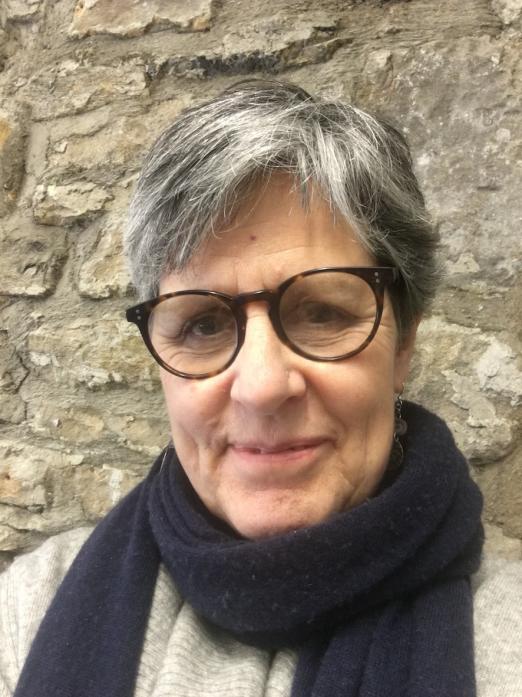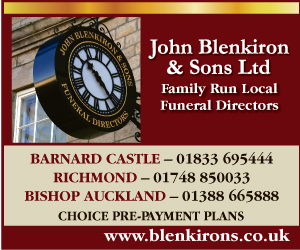
Jill Cole first came to Teesdale in 1990 – initially just for a weekend. Thirty years on she is still here, having brought up her two children and built a career in the arts and cultural sector. She studied at York University and in London and had a brief period working in television before travelling overseas to work with Vietnamese refugees in the Far East. Teesdale was always intended to be a “stopping point” but somehow she has found it impossible to leave.
When did you realise the arts was your passion – does it stem from your childhood/ school days or did it come later?
I think it was quite early on, certainly as far as drama and theatre goes. I always loved dressing up and being in school plays – one of my earliest memories is being an angel in the Nativity clad in an old sheet and some gold tinsel; I graduated a few years later to playing Joseph (a blanket and an old tea towel round my head).
Then at my secondary school (an all-girls convent) I always seemed to get the lead male role in the annual inter-form drama competition, I suspect on account of the fact that I had short hair and didn’t object to wearing a fake moustache. I loved it – both being on stage and helping backstage too.
How did you get involved with the Turrets – and what kept you going with them for so long?
It was through the Castle Players. The Turrets was originally established in 1995 by Mary Stastny as the junior branch of the Players – but no one really had time to organise the group alongside their commitment to the Castle Players. I had a PGCE qualification in English and drama and when no-one else offered I stepped in to rescue the production the children had started rehearsing of Alan Ayckbourn’s Ernie’s Incredible Illucinations.
That was my first attempt at directing and I think I found my calling. The group began to grow and grow – at its peak we had seven groups running, divided according to age, with more than 120 young people taking part.
I have so many fond memories of the 15 years I spent with them – but I think the highlight was when we took 20 members of the seniors to perform their version of Shakespeare’s Othello at the Edinburgh Fringe and they were awarded a four-star review.
Oh – and getting to meet the Queen at an event at Buckingham Palace for services to young people in the performing arts. That was an occasion to remember.
Running the youth theatre was one of the most rewarding things I have ever done – the rewards came in bucketloads from the young people themselves: their energy and enthusiasm, their fresh ideas, their inventiveness and their humour. I’m so pleased that the group has kept going and is now a core part of The Witham.
Which Castle Players production are you most proud of?
I directed a five productions – four “main stage” shows outdoors at The Bowes Museum, one winter show and then in 2016 I also had the chance to direct the team who took part in the Royal Shakespeare Company’s Midsummer Night’s Dream project, where we performed alongside the professionals from the RSC on stage in Newcastle and Stratford and I got to work with the wonderful Erica Whyman, the RSC’s deputy artistic director.
I was also involved with the Castle Players for many years before that, taking part on stage and behind the scenes and for some years volunteered as chairman of the company.
It’s almost impossible to single out any one show but when I think back to my production of The Tempest it always gives me a rather warm glow.
We are lucky to have the Castle Players here in Teesdale – it’s a unique organisation and all credit must go to Simon Pell for setting the bar so high in the first place, way back in 1989 – it was his vision, imagination and professional expertise that has made the company what it is today.
What was the aim of ARTworks in Teesdale?
I helped Judy Caplin to set up ARTworks in Teesdale at a point at which there were no creative holiday activities on offer for children and young people here.
The sports and leisure team at the former Teesdale District Council used to offer a really good holiday activity programme and we felt there should be an equivalent arts offer for young people.
We used to find good quality artists to run all sorts of different arts-based activities in the Easter and summer holidays. It was really popular; we then began offering workshops for other age groups too and the company evolved from there to offering commissions and support for emerging artists. It folded when I was offered a post at Arts Council England and Judy wanted to concentrate more on her own work as an artist.
Where does your love of opera come from?
My dad always loved opera so I grew up hearing the music. I was taken to see my first opera when I was 12 – it was Verdi’s La Traviata and I loved it. I think it’s the combination of performance, lavish sets, ridiculously melodramatic storylines and wonderful music that makes it such a special and uplifting artform.
How do you convince people that opera could be for them?
I think it’s about introducing children to the music at an early age, before any preconceptions about it being elitist and “not for me” set in.
We ran a project with primary schools in Weardale a few years ago introducing Mozart’s The Magic Flute and the response of the children was delightful.
I think we underestimate the ability of our children and young people to be able to hear and appreciate it, though, which is sad.
There is a such a rich world of stunning, passionate music expressing all human emotion that is available to us and so many people go through their lives unaware of it.
But think of the passion of “Nessun Dorma” and how that was popularised through the Italian World Cup – nothing compares to that amazing sound.
With the benefits of hindsight, what are your thoughts on Barnard Castle Vision?
Barnard Castle was lucky to be selected as one of the North East’s “Vision” towns way back in 2008. The opportunity came from the former Regional Development Agency, One North East. But it was a difficult remit – the funding was specifically for “transformative” capital development, which had to be ambitious and challenging in its scope.
I think that perhaps the reality at the time was that local people really didn’t feel the need for transformation – people in Teesdale feel rightly proud of their place and mostly they just wanted streets cleared of dog mess and the public toilets re-opened, which the RDA weren’t that interesting in funding.
Despite some difficult times there have definitely been many lasting legacies – I still love seeing the castle lit up colourfully at night; the Nest gallery was a great venue (before it became a pizza restaurant); the beautiful redeveloped riverside pathways; the tasteful signage through the town, the shopfront improvements – and The Witham definitely wouldn’t be where it is today without the work of the Vision early on.
Out of the Vision came the Heart of Teesdale Landscape Partnership, out of which came Northern Heartlands – so the level of investment generated not just for Barnard Castle but the county as a whole as been immense.
Is Northern Heartlands simply an organisation to support and generate work for the region’s artists or is there more to it?
Northern Heartlands has been one of 16 “Great Place Schemes” running in England since 2017 on the back of the success of the Cities of Culture programme.
It’s a place-based programme using arts, culture and heritage to work with communities and develop people’s confidence to be able to influence the decisions and policies that affect them.
So yes – much more than generating work for artists, it’s about using creative means to make things better in places and very much about working with people.
We haven’t been as visible in Barnard Castle as in other places because there had already been investment here through the Heart of Teesdale, but we’ve hopefully made a difference in places such as Eldon, Shildon and Willington, for example, as well as gaining a national profile for the area.
What are its aims for the future?
Although it was always intended as a three-year programme, in so many ways it feels as if the work has only just started, particularly in some places where there has not been much access to cultural and creative activity in the past.
So we’ve set up Northern Heartlands as a charity in its own right and we’re looking for funding to be able to continue.
Our “unique selling point” is using creativity and artists to work with people and organisations that need to connect with grassroots communities. One of the main strands of our work going forward will be with mental health and wellbeing which is becoming increasingly urgent as a result of lockdown and the Covid pandemic.
Given the impact of Covid-19 on the arts sector and those who work within it, why is it so important to ensure it emerges from the crisis strongly?
The creative industries/ culture sector contributes £10.8billion to the UK economy – or at least it did, pre-Covid.
We have some of greatest culture in the world in this country but the sector is heavily reliant on public subsidy and also on an army of freelancers – artists, actors, musicians, dancers, digital artists and all the support services behind them – for its survival.
Our cultural venues struggle at the best of times and it’s been tragic to see the loss of some great institutions because of the pandemic and I know of professional artists who are just giving up because they can no longer make a living – people have just slipped through the net because they don’t fit the standard profile.
Brexit is already having a devastating impact for artists who tour or train in Europe, so the future is looking really bleak.
But it’s not just about the loss of economic potential. The arts, creativity, culture, heritage – it’s what makes us human.
Think of how people have turned to creative and cultural activities to keep them sane during lockdown, how important it is for our mental health and wellbeing to be able to express ourselves, join with others to make music, to sing, to dance, to write, to paint and make, to laugh and to cry.
We need to continue to support the arts and make sure that the sector is at the centre of all we do.





